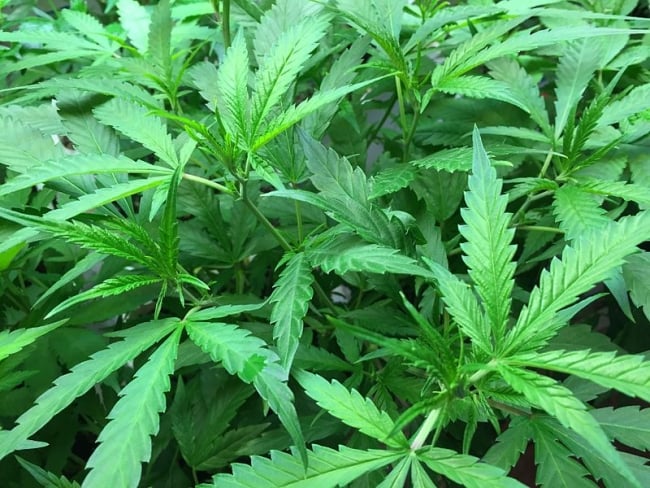You have /5 articles left.
Sign up for a free account or log in.

Wikimedia Commons
While some states have removed criminal penalties for marijuana, and many others have legalized it for medical and -- more rarely -- recreational use, the drug remains forbidden at colleges in such states.
That’s because of a hovering federal threat, but one that has never been realized -- that the government could yank funding to institutions that disobey the law banning drugs on college campuses and public schools.
Public opinion on marijuana has shifted in recent years -- a Pew Research Center survey from last year found 57 percent of American adults said it should be legalized, as opposed to a decade ago, when 60 percent opposed it being legal. Cannabis enjoys particular support among traditional college-age students, meaning they’re more likely to want to smoke it, vape it or bake it into a brownie -- and they have an easier avenue for doing so with the recent move to legalize.
Last year, California, Massachusetts, Nevada and Maine all voted to legalize marijuana, joining Colorado, Oregon, Alaska, Washington and the District of Columbia. Not all states require residents to be 21 to consume.
“Regardless of marijuana’s legal status, colleges should treat marijuana like they treat alcohol in their own internal policies,” said Morgan Fox, communications manager of the Marijuana Policy Project. “Marijuana is much safer than alcohol, and so much less trouble.”
College administrators appear reluctant to take this step, though, largely out of worry that they would infringe on the federal Drug-Free Schools and Communities Act. Representatives from the university systems in both Maine and California cited the 1989 law as the reason policy hasn’t changed.
Many institutions treat alcohol violations far less seriously than possession of drugs including marijuana, a “slap on the wrist” versus potential expulsion, Fox said.
At the University of Maryland, College Park, students have lobbied for reduced punishments for possessing marijuana, which they said would reflect the state’s status as having made it a civil offense in 2014. Anyone 21 or older can be caught with 10 grams of pot or less and just pay a fine, akin to a speeding ticket. The Maryland General Assembly also decriminalized drug paraphernalia.
Members of the student government at Maryland passed a resolution calling for the university to end random drug testing, housing termination, suspension and expulsion as potential consequences for students over 21 found with weed or drug paraphernalia.
The student who drafted the measure, junior Leah Barteldes, said she’s heard that the system for adjudicating marijuana violations is “inconsistent.” Her interest in this topic was first piqued because the country's judicial system has disproportionately sent men and women of color to jail for drug offenses, she said.
Barteldes said she has met with administrators who told her they don’t always enforce the rules for marijuana as described in policy because they often consider it a lesser offense. Barteldes said she’d rather new procedures be created to remove any potential for biases. But because of the federal law, the college’s leaders fear loosening the policies could jeopardize federal funding, Barteldes said.
(Fox, of the Marijuana Policy Project, said he was unaware of any institution having its funding taken away for running afoul of the law.)
University spokeswoman Katie Lawson said because the proposal is in its early stages, it would not weigh in. She provided a statement from the university health center’s director, David McBride, who did not support lifting sanctions.
“Our own School of Public Health has published research that documents the negative academic impact of cannabis use,” McBride said in his statement. “In my opinion, this university needs to do what we can from a policy and enforcement perspective to prevent students from using marijuana. Any other approach would contradict our mission to educate students. Other harms associated with the use of marijuana include the development of psychiatric disorders and increased likelihood of other drug use.”
Many reports have challenged whether marijuana does indeed serve as a “gateway” drug. A 1999 National Institute of Medicine study identified alcohol and nicotine as the first substances that adolescents try. It stated that while “logically” those who use marijuana for the high may be more willing to try other drugs, “there is no evidence that marijuana serves as a stepping-stone on the basis of its particular physiological effect.”
Research has also shown that cannabis poses less health risks than alcohol, with not a single documented fatal overdose of the drug, Fox said. It also does not inspire the same sort of violent behavior that alcohol tends to bring out in some abusers, he said.
Sydney Heise, president of Students for Sensible Drug Policy at UMD, said she has witnessed this phenomenon firsthand. The university will often send out mass emails warning students against intoxicated individuals, but marijuana just doesn’t result in the same sort of brawls, she said.
Her group has backed the resolution, and she said she believes by and large, the student body approves of it, too.
“This university feels, in some ways, like a symbol for … hypocrisy,” one student, Jack Lewis, wrote in an opinion piece in the student newspaper, The Diamondback. “We are a flagship institution in a state that decriminalized possession of small amounts of the drug and yet fall in line with national laws that categorically ban it.”
The college’s residence life drug policy, approved in August 1991, warns students that if they possess or sell any illegal drug, they “in all likelihood” would immediately be removed from housing or suspended or expelled from the university. Barteldes in her interview highlighted how old the policy is.
Other university systems have taken similar stances. The University of California, in one of the most liberal states in the country, where recreational cannabis use is legal, explicitly forbids marijuana on any campus, with no intent to change the policy, said spokeswoman Claire Doan.
Maine, despite voters having legalized marijuana in a referendum vote, hasn’t set up any structure for the sale of legal marijuana sales because its Republican governor, Paul LePage, vetoed a bill that would do so.
Disregarding this fight, the University of System of Maine still wouldn’t alter its policies, according to a memo distributed by the system’s general counsel.
Another particularly tough dynamic is the students who might consume marijuana for medicinal purposes -- even with a prescription, colleges generally won’t allow it, often forcing them into off-campus living situations.
The Drug-Free Schools and Communities Act does also not distinguish between medical and nonmedical weed, though advocates have made some minor legal headway on this front.
A court of appeals in Arizona earlier this year overturned a state law criminalizing medical marijuana on college campuses. In 2010, the state legalized medical cannabis but set out certain areas where it wasn’t allowed, such as public schools, school buses and correctional facilities. Though the judge in the case ruled against lawmakers, he did note that nothing bars colleges from setting their own rules on when marijuana was allowed on the grounds. Arizona institutions have banned medical marijuana from campuses.
Legalization in other states does not seem to have majorly disrupted operations.
A spokesman from University of Colorado, Boulder, told The Boston Globe last year that policy hasn’t shifted in Colorado, but he hadn’t seen evidence police dealt with any more marijuana-related incidents in recent years. The Globe also reported that Massachusetts institutions would not permit marijuana on campuses.
Evidence suggests that college students do take advantage of more liberal weed laws. One study found that Oregon students were using more marijuana since its legalization in 2015. While the report’s authors noted the increase, they also said the effects of this boom and weed’s legalization had yet to be more fully studied.







